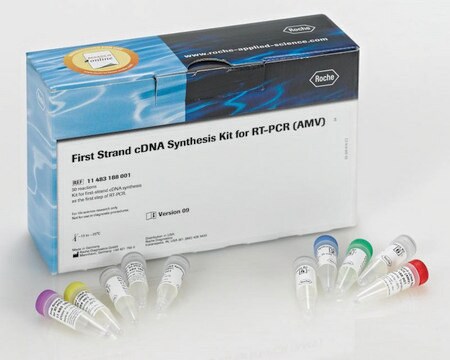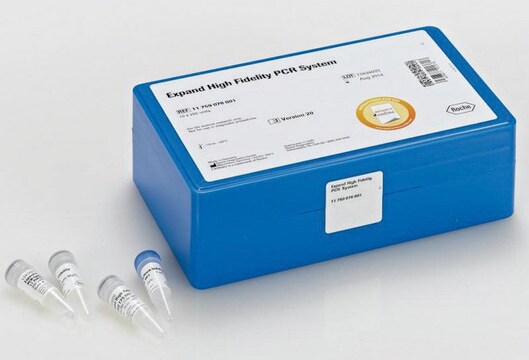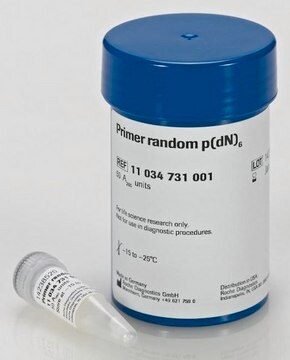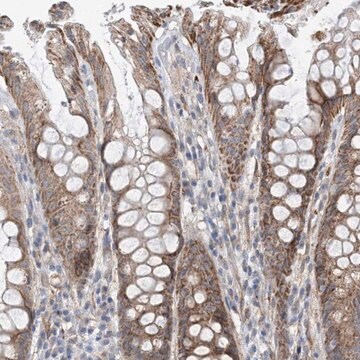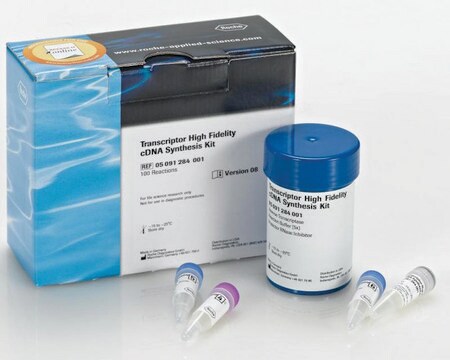03353621001
Roche
5′/3′ RACE Kit, 2nd Generation
sufficient for 10 reactions
Se connecterpour consulter vos tarifs contractuels et ceux de votre entreprise/organisme
About This Item
Code UNSPSC :
41106313
Nomenclature NACRES :
NA.55
Produits recommandés
Utilisation
sufficient for 10 reactions
Niveau de qualité
Fabricant/nom de marque
Roche
Conditions d'expédition
dry ice
Température de stockage
−20°C (−15°C to −25°C)
Description générale
Rapid Amplification of cDNA ends (RACE) is a prevalent technique used to rapidly obtain full-length cDNA from partially known sequences. The 5′/3′ RACE kit contains Transcriptor Reverse Transcriptase and recombinant Terminal Transferase. Transcriptor Reverse Transcriptase transcribes full-length cDNA for the highly sensitive and rapid amplification of either 5′ or 3′ cDNA fragments up to 14 kb. Due to its thermostability (up to +65 °C), it can work with GC-rich templates with high secondary structure. High sensitivity can be achieved using Transcriptor Reverse Transcriptase, resulting in highly efficient cDNA synthesis and the generation of long RACE products. Recombinant Terminal transferase is used to add a homopolymeric A-tail to the 3′ end of the cDNA. The poly(A)+ tail decreases the likelihood of inappropriate truncation by the oligo(dT)-anchor primer, and overcomes the weaker A/T compared to the G/C hybridization. Moreover, longer stretches of A residues are required before the oligo(dT)-anchor primer can hybridize to an internal site and can truncate the amplification product. Tailed cDNA is amplified by PCR using a gene-specific primer and the oligo(dT)-anchor primer. The obtained cDNA is further amplified by a second PCR using a nested specific primer and the PCR-anchor primer, allowing RACE products to be cloned into an appropriate vector for subsequent studies.
Spécificité
Heat inactivation: Terminal Transferase: 70 °C for 10 minutes
Transcriptor Reverse Transcriptase: 85 °C for 5 minutes
Transcriptor Reverse Transcriptase: 85 °C for 5 minutes
Application
5′/3′ RACE Kit, 2nd Generation is suitable for
- Structural and expression studies of RNA molecules
- Generating full-length cDNAs
- Isolation and characterization of 5′ or 3′ ends from low-copy RNA messages
- first strand cDNA synthesis
- Amplification and further cloning of rare mRNAs
- Use in conjunction with exon-trapping methods
- Products of the RACE reaction can be directly sequenced without cloning
Caractéristiques et avantages
- Robust performance: Recombinant Transcriptor Reverse Transcriptase allows procession through regions of difficult secondary RNA structure.
- Convenient: Function and expression studies of either 5′ or 3′ end of the RNA can be performed with the same kit.
- Reliable: dA tailing of cDNA with Recombinant Terminal Transferase decreases the likelihood of inappropriate truncation.
- Reproducible: Oligo dT-anchor primer with non 3′dT ensures correct binding to the inner end of the poly (A) tail.
- Produce long fragments: Generate cDNA up to 14kb in length with Transcriptor Reverse Transcriptase.
The control reaction includes transcription of the control RNA into first-strand cDNA using the control primer neo1/rev. Amplification of the cDNA is performed using the control primer neo2/rev and neo3/for to obtain a 157-bp PCR product. Tailing of the purified cDNA is performed with dATP. Amplification of the tailed cDNA is performed with oligo dT-anchor primer and the control primer neo2/rev to obtain a 293-bp PCR product.
Conditionnement
1 kit containing 12 components
Autres remarques
For life science research only. Not for use in diagnostic procedures.
Composants de kit seuls
Réf. du produit
Description
- cDNA Synthesis Buffer 5x concentrated
- Transcriptor Reverse Transcriptase 20 U/μl
- Deoxynucleotide Mix
- dATP, pH 7.5 (20 °C)
- Reaction Buffer 10x concentrated
- Terminal Transferase, recombinant
- Control neo-RNA 1 ng/μl
- Oligo dT-Anchor Primer
- PCR Anchor Primer
- Control Primer neo1/rev primer 12.5 μM
- Control Primer neo2/rev primer 12.5 μM
- Control Primer neo3/for primer 12.5 μM
Afficher tout (12)
Code de la classe de stockage
12 - Non Combustible Liquids
Classe de danger pour l'eau (WGK)
WGK 1
Point d'éclair (°F)
does not flash
Point d'éclair (°C)
does not flash
Faites votre choix parmi les versions les plus récentes :
Déjà en possession de ce produit ?
Retrouvez la documentation relative aux produits que vous avez récemment achetés dans la Bibliothèque de documents.
Les clients ont également consulté
D Chen et al.
BioTechniques, 30(3), 574-580 (2001-03-17)
In determining the terminal sequences of the genomic dsRNAs of rotavirus by 5'-rapid amplification of cDNA ends (5'-RACE), it was found that most of the viral cDNAs contained extra nucleotides at their 5' termini that had not been reported before
Rapid amplification of cDNA ends (RACE)
Yeku O and Frohman MA
Methods in Molecular Biology, 107-122 (2011)
Rapid amplification of 5 [prime] complementary DNA ends (5 [prime] RACE)
Sambrook J and Russell DW
Nature methods, 2, 629-630 (2005)
Erdong Cheng et al.
Journal of virology, 86(18), 10173-10185 (2012-07-13)
Hantaviruses, similarly to other negative-strand segmented RNA viruses, initiate the synthesis of translation-competent capped mRNAs by a unique cap-snatching mechanism. Hantavirus nucleocapsid protein (N) binds to host mRNA caps and requires four nucleotides adjacent to the 5' cap for high-affinity
Pengli Bu et al.
The Journal of endocrinology, 234(2), 217-232 (2017-06-04)
Mammals share common strategies for regulating reproduction, including a conserved hypothalamic-pituitary-gonadal axis; yet, individual species exhibit differences in reproductive performance. In this report, we describe the discovery of a species-restricted homeostatic control system programming testis growth and function. Prl3c1 is
Articles
5'/3' RACE Kit, 2nd Generation Troubleshooting
Notre équipe de scientifiques dispose d'une expérience dans tous les secteurs de la recherche, notamment en sciences de la vie, science des matériaux, synthèse chimique, chromatographie, analyse et dans de nombreux autres domaines..
Contacter notre Service technique